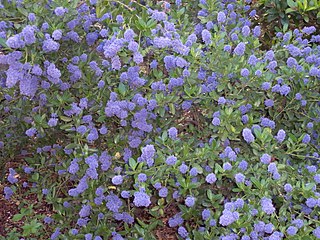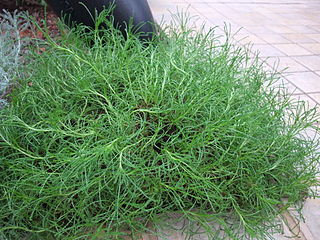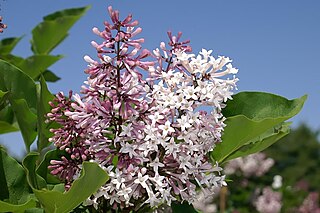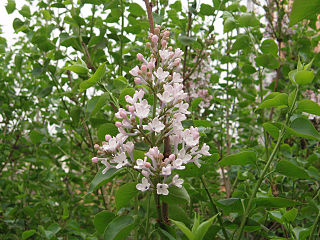
Syringa is a genus of 12 currently recognized species of flowering woody plants in the olive family or Oleaceae called lilacs. These lilacs are native to woodland and scrub from southeastern Europe to eastern Asia, and widely and commonly cultivated in temperate areas elsewhere.

Philadelphus (mock-orange) is a genus of about 60 species of shrubs from 3–20 ft tall, native to North America, Central America, Asia and (locally) in southeast Europe.

Fuchsia is a genus of flowering plants that consists mostly of shrubs or small trees.

Dasiphora fruticosa is a species of hardy deciduous flowering shrub in the family Rosaceae, native to the cool temperate and subarctic regions of the northern hemisphere, often growing at high altitudes in mountains. Dasiphora fruticosa is still widely referenced in the horticultural literature under its synonym Potentilla fruticosa. Common names include shrubby cinquefoil, golden hardhack, bush cinquefoil, shrubby five-finger, widdy, and kuril tea.

Berberis, commonly known as barberry, is a large genus of deciduous and evergreen shrubs from 1–5 m (3.3–16.4 ft) tall, found throughout temperate and subtropical regions of the world. Species diversity is greatest in South America and Asia; Europe, Africa and North America have native species as well. The best-known Berberis species is the European barberry, Berberis vulgaris, which is common in Europe, North Africa, the Middle East, and central Asia, and has been widely introduced in North America. Many of the species have spines on the shoots and all along the margins of the leaves.

Syringa vulgaris, the lilac or common lilac, is a species of flowering plant in the olive family Oleaceae, native to the Balkan Peninsula, where it grows on rocky hills. Grown in spring for its scented flowers, this large shrub or small tree is widely cultivated and has been naturalized in parts of Europe, Asia and North America. It is not regarded as an aggressive species. It is found in the wild in widely scattered sites, usually in the vicinity of past or present human habitations.

Helianthemum, known as rock rose, sunrose, rushrose, or frostweed, is a genus of about 110 species of flowering plants in the family Cistaceae. They are widely distributed throughout the Northern Hemisphere, especially in the Mediterranean.

Vinca major, with the common names bigleaf periwinkle, large periwinkle, greater periwinkle and blue periwinkle, is a species of flowering plant in the family Apocynaceae, native to the western Mediterranean. Growing to 25 cm (10 in) tall and spreading indefinitely, it is an evergreen perennial, frequently used in cultivation as groundcover.

Syringa reticulata, the Japanese tree lilac, is a species of flowering plant in the family Oleaceae native to eastern Asia, which is grown as an ornamental in Europe and North America.

Ceanothus thyrsiflorus, known as blueblossom or blue blossom ceanothus, is an evergreen shrub in the buckthorn family Rhamnaceae that is endemic to Oregon and California in the US. The term 'Californian lilac' is also applied to this and other varieties of ceanothus, though it is not closely related to Syringa, the true lilac.

Salvia microphylla, the baby sage, Graham's sage, or blackcurrant sage, is an evergreen shrub found in the wild in southeastern Arizona and the mountains of eastern, western, and southern Mexico. It is a very complex species which easily hybridizes, resulting in numerous hybrids and cultivars brought into horticulture since the 1990s. The specific epithet microphylla, from the Greek, means "small leaved". In Mexico it is called mirto de montes, or "myrtle of the mountains".

Santolina rosmarinifolia, the holy flax, is a species of flowering plant in the daisy family Asteraceae, native to south western Europe. It is a dense, compact evergreen shrub growing to 60 cm (24 in) tall and wide, with narrow, aromatic green leaves and tight yellow composite flowerheads carried on slender stalks above the foliage, in summer.

Acer palmatum, commonly known as Japanese maple, palmate maple, or smooth Japanese maple (Japanese: irohamomiji, イロハモミジ, or momiji,, is a species of woody plant native to Japan, Korea, China, eastern Mongolia, and southeast Russia. Many different cultivars of this maple have been selected and they are grown worldwide for their large variety of attractive forms, leaf shapes, and spectacular colors.

Iris unguicularis, the Algerian iris, is a rhizomatous flowering plant in the genus Iris, native to Greece, Turkey, Western Syria, and Tunisia. It grows to 30 centimetres (12 in), with grassy evergreen leaves, producing pale lilac or purple flowers with a central band of yellow on the falls. The flowers appear in winter and early spring. They are fragrant, with pronounced perianth tubes up to 20 cm (7.9 in) long.

Coronilla valentina, the shrubby scorpion-vetch, scorpion vetch or bastard senna, is a species of flowering plant in the genus Coronilla of the legume family Fabaceae, native to the Mediterranean Basin, and introduced into Kenya and the United States. It is an evergreen shrub growing to 80 cm (31 in) tall and wide, with pea-like foliage and fragrant, brilliant yellow flowers in spring and summer, followed by slender pods. Linnaeus observed that the flowers, remarkably fragrant in the daytime, are almost scentless at night.

Rhododendron argyrophyllum (银叶杜鹃) is a species of flowering plant in the heath family Ericaceae. It is native to forested slopes at 1,600–2,300 m (5,200–7,500 ft) in E and NW Guizhou, S and W Sichuan, and NE Yunnan in China.

Nepeta racemosa, the dwarf catnip or raceme catnip, syn. N. mussiniii, is a species of flowering plant in the mint family Lamiaceae, native to the Caucasus, Turkey and northern Iran. Growing to 30 cm (12 in) tall by 45 cm (18 in) wide, it is a herbaceous perennial with aromatic leaves and violet or lilac-blue flowers in summer.

The Miss Kim lilac is a subspecies of lilac which was categorized by Elwyn M. Meader while stationed in Korea as an army horticulturalist. It was supposedly named after Elwyn M. Meader's Korean helper, whose name was "Kim." This species is endemic to the areas of Korea and Northeast China. The most commonly used name for this subspecies is Miss Kim Lilac yet there are many others used. Flowers produced by this species are of pink, purple, and a light blue hues which accompany a sweet smelling aroma. Alongside flower production fruits called loculicidal capsules are produced. This species tends to bloom in the spring months.

Syringa oblata is a species in the genus Syringa, in the family Oleaceae. It is also known as early blooming lilac or broadleaf lilac.

Syringa oblatasubsp.dilatata, also known as Korean early lilac, is a subspecies of the species Syringa oblata in the genus Syringa, in the family Oleaceae.




















